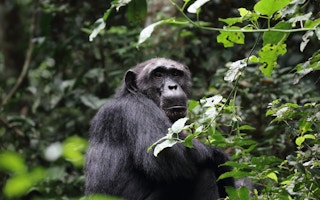“Sierra Leone has one of the largest populations of chimpanzees, but protecting their environment from human encroachment is not happening, so why the pretence?”
This was the response of one Facebooker to the country’s new passport, which prominently features a chimpanzee, the national animal since 2019.
The public reaction to the design – decided on by the immigration department without public consultation and intended to raise the animal’s profile to boost tourism – placed the spotlight on Sierra Leone’s western chimpanzee population with an intensity not seen since 2006. In that year, a male chimp named Bruno successfully led the escape of 31 chimps from the Tacugama Chimpanzee Sanctuary near Freetown, the country’s capital, killing one person in the process.
Throughout January this year, images of the critically endangered primate were trending among Sierra Leonean Facebook communities in reaction to the new travel document.
“Babu [chimp] face on a passport where tourism is literally non-existent and endangered animals are killed on sight while the government remains mute,” one commentator wrote, highlighting the gap between the celebration of the animal and the government’s failure to address conservation challenges.
Some people also highlighted that using images of chimps on an international travel document may reinforce racial stereotypes.
Not all responses were negative, however. “I am sure the changes will attract more tourists,” one commenter stated.
To many, the debate is an opportunity to learn about the challenges facing the western chimpanzee amid Sierra Leone’s eroding biodiversity.
“
Sierra Leone has the second largest population [of western chimpanzees in Africa], which means that chimpanzees can better represent our national animal than lions, which we are not sure of having. You need a tourism identity that you can refer to as the icon. If you don’t have that, it will be very difficult to present your country for tourism.
Dr Memunatu Pratt, tourism minister, Sierra Leone
Although many have been lost, the country still has one of the largest populations of the animal. The only available national data, from 2010, estimated the number to be 5,500, with more than half living outside protected areas. Sierra Leone’s civil war of 1991 to 2002, unchecked deforestation driven by rapid urbanisation, hunting for bushmeat and the pet trade, timber logging, slash and burn farming, and charcoal burning, have all pushed the chimpanzee close to local extinction.
Additional challenges include low public awareness about wildlife protection and outdated legislation, with laughable penalties of sometimes less than a dollar for killing a critically endangered chimp.
Tourism minister Dr Memunatu Pratt, speaking in response to the social media storm, cited some of these reasons as behind the government’s decision to publicise the chimps.
“Sierra Leone has the second largest population [of western chimpanzees in Africa], which means that chimpanzees can better represent our national animal than lions, which we are not sure of having,” she said. “You need a tourism identity that you can refer to as the icon. If you don’t have that, it will be very difficult to present your country for tourism.”
Although some work has been done since the 1990s, with the government supporting the establishment of the Tacugama sanctuary, and more recently declaring the primate as the national animal, problems persist.
Widespread deforestation remains the biggest threat to chimpanzees, with 84 per cent of the areas frequented by chimps overlapping with areas considered suitable for oil palm development, the International Union for Conservation of Nature (IUCN) reports; that figure is 94 per cent in neighbouring Liberia.
The Tacugama sanctuary estimated in 2020 that if the decline of the western chimpanzee continues at the current rate, 99 per cent of the remaining population will be extinct by 2060.
The Sierra Leone government is also struggling to enforce punitive measures, including jail terms and fines, that deter people from encroaching on the habitat of chimps and for hunting them for meat and pets.
If the government is committed to using the primates as the national animal, then it must also commit to taking conservation efforts seriously. It must urgently stop the rampant deforestation in the Western Area Peninsula National Park. The park covers about 17,000 hectares of closed canopy forest, and is home to 80–90 per cent of Sierra Leone’s terrestrial biodiversity, according to UNESCO.
For its part, the Tacugama sanctuary is campaigning for new national wildlife laws that would provide sufficient deterrent to stop hunting and trade in endangered species.








